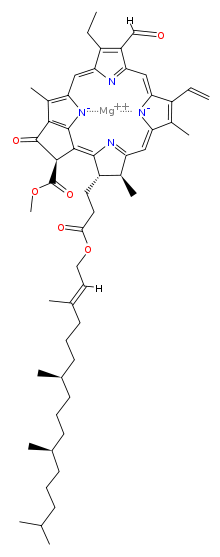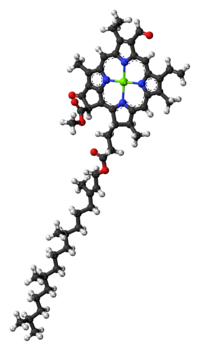엽록소 b

| |
| 이름 | |
|---|---|
| IUPAC 이름
chlorophyll b
| |
| 체계명
magnesium [methyl (3S,4S,21R)-14-ethyl-13-formyl-4,8,18-trimethyl-20-oxo-3-(3-oxo-3-[(2E,7R,11R)-3,7,11,15-tetramethyl-2-hexadecen-1-yl]oxy}propyl)-9-vinyl-21-phorbinecarboxylatato(2-)-κ2N,N′] | |
| 별칭
β-chlorophyll
| |
| 식별자 | |
3D 모델 (JSmol)
|
|
| ChemSpider | |
| ECHA InfoCard | 100.007.522 |
| EC 번호 |
|
| E 번호 | E140 (착색제) |
PubChem CID
|
|
| UNII | |
CompTox Dashboard (EPA)
|
|
| |
| |
| 성질 | |
| C55H70MgN4O6 | |
| 몰 질량 | 907.492 g·mol−1 |
| 겉보기 | 녹색 |
| 냄새 | 무취 |
| 녹는점 | ~ 125 °C (257 °F; 398 K)[1] |
| 불용성[1] | |
| 용해도 | 에탄올, 에터, 피리딘에 잘 용해됨, 메탄올에 용해됨[1] |
| 흡광도 | See text |
달리 명시된 경우를 제외하면, 표준상태(25 °C [77 °F], 100 kPa)에서 물질의 정보가 제공됨.
| |
엽록소 b(葉綠素 b, 영어: chlorophyll b)는 엽록소의 한 형태이다. 엽록소 b는 빛 에너지를 흡수하여 광합성을 돕는다. 엽록소 b는 카보닐기 때문에 극성 용매에서 엽록소 a보다 더 잘 녹는다. 색상은 녹색이며, 주로 청색광을 흡수한다.[2]
육상 식물에서는 광계 II 주변의 광수집 복합체에 엽록소 b의 대부분이 포함되어 있다. 따라서 광계 I에 대한 광계 II의 비율이 증가된 음지에 적응한 엽록체에서는 엽록소 a에 대한 엽록소 b의 비율이 높다.[3] 엽록소 b가 증가하면 음지에 적응한 엽록체가 흡수하는 빛의 파장의 범위가 더 증가하기 때문에 이는 적응적인 현상이다.
 |
생합성[편집]
엽록소 b의 생합성 경로는 다양한 효소들을 활용한다.[4] 대부분의 식물에서 엽록소는 글루탐산으로부터 유도되며 헴 및 시로헴과 공유하는 분지 경로를 따라 합성된다.[5][6][7] 초기 단계에서 글루탐산을 5-아미노레불린산(ALA)과 통합한다. 2분자의 5-아미노레불린산은 포르포빌리노젠(PBG)로 환원되고, 4분자의 포르포빌리노젠은 결합하여 프로토포르피린 IX를 생성한다.
엽록소 생성효소(EC 2.5.1.62)[8]는 다음과 같은 반응을 촉매하여 엽록소 b의 생합성을 완료하는 효소이다.[9][10]
- 클로로필라이드 b + 피틸 이인산 ⇄ 엽록소 b + 이인산
이는 20탄소 화합물인 다이테르펜 알코올 피톨과 함께 클로로필라이드 b의 카복실기의 에스터를 형성한다.
구조[편집]
 |

|
| 긴 탄화수소 꼬리를 보여주는 엽록소 b의 분자 구조 | |
같이 보기[편집]
각주[편집]
- ↑ 가 나 다 Lide, David R., 편집. (2009). 《CRC Handbook of Chemistry and Physics》 90판. Boca Raton, Florida: CRC Press. ISBN 978-1-4200-9084-0.
- ↑ “Photosynthesis pigments”. 2012년 9월 5일에 원본 문서에서 보존된 문서. 2011년 1월 13일에 확인함.
- ↑ Kitajima, Kaoru; Hogan, Kevin P (2003). “Increases of chlorophyll a/b ratios during acclimation of tropical woody seedlings to nitrogen limitation and high light”. 《Plant, Cell & Environment》 26 (6): 857–865. doi:10.1046/j.1365-3040.2003.01017.x. PMID 12803613.
- ↑ Suzuki JY, Bollivar DW, Bauer CE (1997). “Genetic analysis of chlorophyll biosynthesis”. 《Annual Review of Genetics》 31 (1): 61–89. doi:10.1146/annurev.genet.31.1.61. PMID 9442890.
- ↑ Battersby, A. R. (2000). “Tetrapyrroles: the Pigments of Life. A Millennium review”. 《Nat. Prod. Rep.》 17 (6): 507–526. doi:10.1039/B002635M. PMID 11152419.
- ↑ Akhtar, M. (2007). 〈The Modification of Acetate and Propionate Side Chains During the Biosynthesis of Haem and Chlorophylls: Mechanistic and Stereochemical Studies〉. 《Ciba Foundation Symposium 180 - the Biosynthesis of the Tetrapyrrole Pigments》. Novartis Foundation Symposia 180. 131–155쪽. doi:10.1002/9780470514535.ch8. ISBN 9780470514535. PMID 7842850.
- ↑ Willows, Robert D. (2003). “Biosynthesis of chlorophylls from protoporphyrin IX”. 《Natural Product Reports》 20 (6): 327–341. doi:10.1039/B110549N. PMID 12828371.
- ↑ Schmid, H. C.; Rassadina, V.; Oster, U.; Schoch, S.; Rüdiger, W. (2002). “Pre-Loading of Chlorophyll Synthase with Tetraprenyl Diphosphate is an Obligatory Step in Chlorophyll Biosynthesis” (PDF). 《Biological Chemistry》 383 (11): 1769–78. doi:10.1515/BC.2002.198. PMID 12530542. S2CID 3099209.
- ↑ Eckhardt, Ulrich; Grimm, Bernhard; Hortensteiner, Stefan (2004). “Recent advances in chlorophyll biosynthesis and breakdown in higher plants”. 《Plant Molecular Biology》 56 (1): 1–14. doi:10.1007/s11103-004-2331-3. PMID 15604725. S2CID 21174896.
- ↑ Bollivar, David W. (2007). “Recent advances in chlorophyll biosynthesis”. 《Photosynthesis Research》 90 (2): 173–194. doi:10.1007/s11120-006-9076-6. PMID 17370354. S2CID 23808539.
